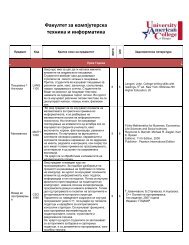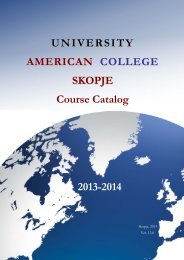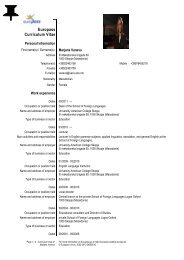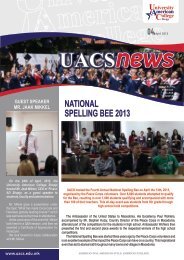UACS Collection of Abstracts 2011 - University American College ...
UACS Collection of Abstracts 2011 - University American College ...
UACS Collection of Abstracts 2011 - University American College ...
Create successful ePaper yourself
Turn your PDF publications into a flip-book with our unique Google optimized e-Paper software.
appearance EUROSIM, Prague, Czech Republic ‐ September 6‐10, 2010Title <strong>of</strong> the paperAbstractKeywordsJEL classificationIterative System for Simulation <strong>of</strong> E2E Transport Protocols in HeterogeneousNetworksThe Internet is characterized by the ever‐increasing number <strong>of</strong> connections,nodes and places <strong>of</strong> presence, kinds <strong>of</strong> topologies, transmission mediatechnologies, the yearly growth in user communities by magnitudes, thevariety and the potential <strong>of</strong> innovative applications, combined with theeconomic, social, cultural and political ramifications. While constantly beingmeasured and evaluated, explored and studied, the Internet is arguablyimpossible to be used for experimentation and investigations in order to testand validate the modifications <strong>of</strong> the existing network protocols or theintroduction <strong>of</strong> new ones. Studies are commonly done using laboratoryconditions through tests beds or simulation environments. The ns‐2 networksimulator is a well‐known open source tool extensively used and extendedby the academia, who also needs a standardized set <strong>of</strong> topologies, traffics,and metrics to validate and verify the results <strong>of</strong> their efforts. The tcpeval isone <strong>of</strong> these tools tool designed to provide a standard starting researchframework. The goal <strong>of</strong> the paper is tw<strong>of</strong>old: using ns‐2 and tcpeval as toolsfor creating a simulation platform enriched with data gathering system andevaluation <strong>of</strong> the performance <strong>of</strong> an end‐to‐end transport scheme based onan original TCP modification.Simulation, E2E Protocols, Transport Protocols, ns‐2, tcpeval, HeterogeneousNetworksAuthor(s)Journal <strong>of</strong> paperappearanceConference <strong>of</strong> paperappearanceTitle <strong>of</strong> the paperAbstractMilenkoski Aleksandar, Stojcevska BiljanaInternational Journal <strong>of</strong> Distributed and Parallel systems (IJDPS) Vol.1, No.1,September 2010Loss Differentiation Algorithms Vs. Congestion Control Schemes: DynamicsAnd PerformanceThis paper carefully analyzes the behavior <strong>of</strong> different congestion controlschemes when used in combination with Loss Differentiation Algorithm.Three types <strong>of</strong> congestion schemes are discussed: delay‐based, bandwidthestimation and AIMD, with one TCP variant representing each congestionscheme. We simulated two network scenarios with diverse link and trafficproperties and evaluated the congestion schemes with integrated LossDifferentiation Algorithm in each <strong>of</strong> them. The integrated LossDifferentiation Algorithm is ideal, i.e. it makes no errors in its judgment. Thebehavior <strong>of</strong> the schemes is analyzed from aspect <strong>of</strong>: the properties <strong>of</strong> theemployed mathematical functions, the effect <strong>of</strong> presence or absence <strong>of</strong>additional network load (reverse and background traffic), and the achievedthroughput. The results show very diverse scene and pinpoint theimportance <strong>of</strong> the careful and delicate design <strong>of</strong> the congestion avoidanceaction when a non‐congestion loss is detected.39


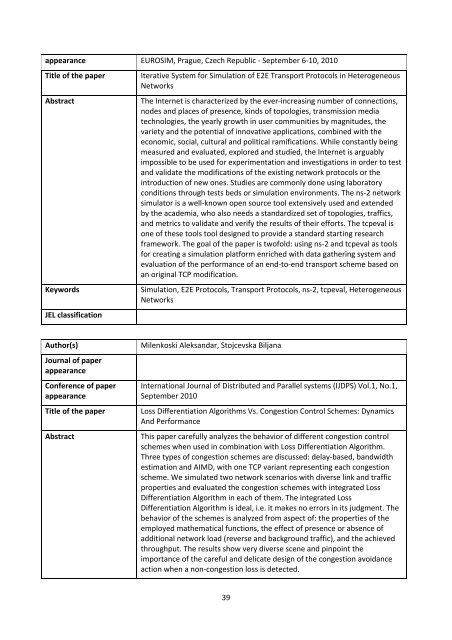
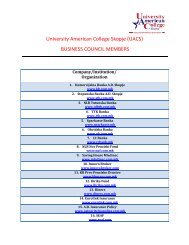

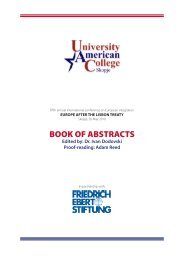

![amerikan kolex ]e bide prv univerzitet od treta generacija vo ...](https://img.yumpu.com/47278343/1/190x252/amerikan-kolex-e-bide-prv-univerzitet-od-treta-generacija-vo-.jpg?quality=85)

